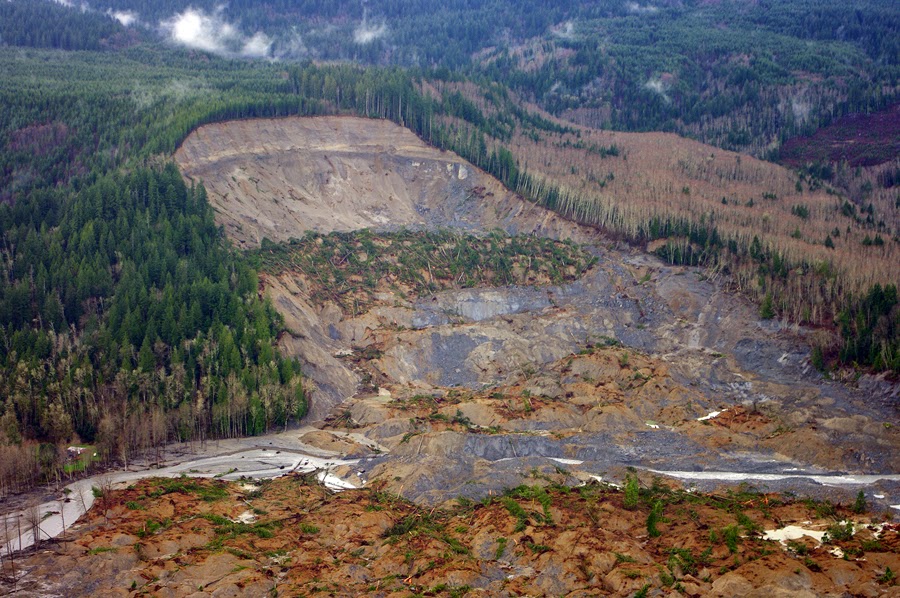
A landslide, also known as a landslip, is a geological phenomenon that includes a wide range of ground movements, such as rockfalls, deep failure of slopes and shallow debris flows. Landslides can occur in offshore, coastal and onshore environments. Although the action of gravity is the primary driving force for a landslide to occur, there are other contributing factors affecting the original slope stability. Typically, pre-conditional factors build up specific sub-surface conditions that make the area/slope prone to failure, whereas the actual landslide often requires a trigger before being released.
Causes of landslides
The causes of landslides are usually related to instabilities in slopes. It is usually possible to identify one or more landslide causes and one landslide trigger. The difference between these two concepts is subtle but important. The landslide causes are the reasons that a landslide occurred in that location and at that time. Landslide causes are listed in the following table, and include geological factors, morphological factors, physical factors and factors associated with human activity.
Causes may be considered to be factors that made the slope vulnerable to failure, that
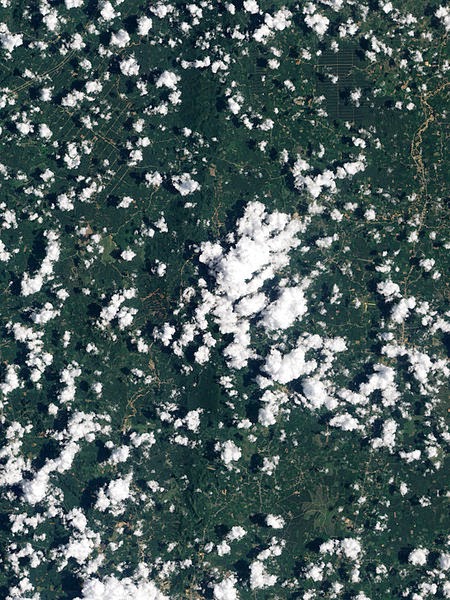
predispose the slope to becoming unstable. The trigger is the single event that finally initiated the landslide. Thus, causes combine to make a slope vulnerable to failure, and the trigger finally initiates the movement. Landslides can have many causes but can only have one trigger as shown in the next figure. Usually, it is relatively easy to determine the trigger after the landslide has occurred (although it is generally very difficult to determine the exact nature of landslide triggers ahead of a movement event).
Geological causes
- Weathered Materials e.g. heavy rainfall
- Sheared materials
- Jointed or fissured materials
- Adversely orientated discontinuities
- Permeability contrasts
- Material contrasts
- Rainfall and snow fall
- Earthquakes
Morphological causes
- Slope angle
- Uplift
- Rebound
- Fluvial erosion
- Wave erosion
- Glacial erosion
- Erosion of lateral margins
- Subterranean erosion
- Slope loading
- Vegetation change
- Erosion
Physical causes
- Intense rainfall
- Rapid snow melt
- Prolonged precipitation
- Rapid drawdown
- Earthquake
- Volcanic eruption
- Thawing
- Freeze-thaw
- Ground water changes
- Soil pore water pressure
- Surface runoff
- Seismic activity
- Soil erosion
Human causes
- Excavation
- Loading
- Draw-down
- Land use (e.g. construction of roads, houses etc.)
- Water management
- Mining
- Quarrying
- Vibration
- Water leakage
- Deforestation
- Land use pattern
- Pollution
Although there are multiple types of causes of landslides, the three that cause most of the damaging landslides around the world are these:
Landslides and Water
Slope saturation by water is a primary cause of landslides. This effect can occur in the form of intense rainfall, snowmelt, changes in ground-water levels, and water-level changes along coastlines, earth dams, and the banks of lakes, reservoirs, canals, and rivers.
Landsliding and flooding are closely allied because both are related to precipitation, runoff, and the saturation of ground by water. In addition, debris flows and mudflows usually occur in small, steep stream channels and often are mistaken for floods; in fact, these two events often occur simultaneously in the same area.
Landslides can cause flooding by forming landslide dams that block valleys and stream channels, allowing large amounts of water to back up. This causes backwater flooding and, if the dam fails, subsequent downstream flooding. Also, solid landslide debris can “bulk” or add volume and density to otherwise normal streamflow or cause channel blockages and diversions creating flood conditions or localized erosion. Landslides can also cause overtopping of reservoirs and/or reduced capacity of reservoirs to store water.
Landslides and Seismic Activity
Many mountainous areas that are vulnerable to landslides have also experienced at least moderate rates of earthquake occurrence in recorded times. The occurrence of earthquakes in steep landslide-prone areas greatly increases the likelihood that landslides will occur, due to ground shaking alone or shaking-caused dilation of soil materials, which allows rapid infiltration of water. The 1964 Great Alaska Earthquake caused widespread landsliding and other ground failure, which caused most of the monetary loss due to the earthquake. Other areas of the United States, such as California and the Puget Sound region in Washington, have experienced slides, lateral spreading, and other types of ground failure due to moderate to large earthquakes. Widespread rockfalls also are caused by loosening of rocks as a result of ground shaking. Worldwide, landslides caused by earthquakes kill people and damage structures at higher rates than in the United States.
Landslides and Volcanic Activity
Landslides due to volcanic activity are some of the most devastating types. Volcanic lava may melt snow at a rapid rate, causing a deluge of rock, soil, ash, and water that accelerates rapidly on the steep slopes of volcanoes, devastating anything in its path. These volcanic debris flows (also known as lahars) reach great distances, once they leave the flanks of the volcano, and can damage structures in flat areas surrounding the volcanoes. The 1980 eruption of Mount St. Helens, in Washington triggered a massive landslide on the north flank of the volcano, the largest landslide in recorded times.
Types
Debris flow
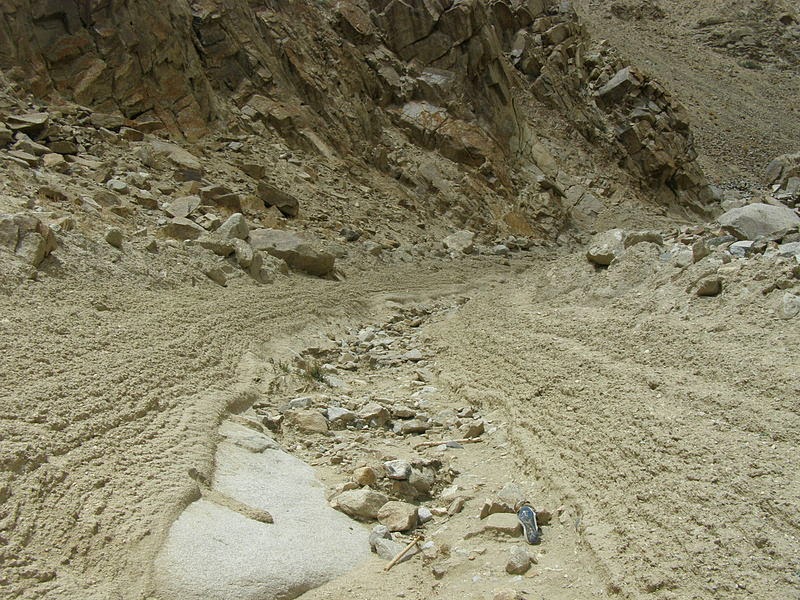
Slope material that becomes saturated with water may develop into a debris flow or mud flow. The resulting slurry of rock and mud may pick up trees, houses and cars, thus blocking bridges and tributaries causing flooding along its path.
Debris flow is often mistaken for flash flood, but they are entirely different processes.
Muddy-debris flows in alpine areas cause severe damage to structures and infrastructure and often claim human lives. Muddy-debris flows can start as a result of slope-related factors and shallow landslides can dam stream beds, resulting in temporary water blockage. As the impoundments fail, a “domino effect” may be created, with a remarkable growth in the volume of the flowing mass, which takes up the debris in the stream channel. The solid-liquid mixture can reach densities of up to 2 tons/m³ and velocities of up to 14 m/s (Chiarle and Luino, 1998; Arattano, 2003). These processes normally cause the first severe road interruptions, due not only to deposits accumulated on the road (from several cubic metres to hundreds of cubic metres), but in some cases to the complete removal of bridges or roadways or railways crossing the stream channel. Damage usually derives from a common underestimation of mud-debris flows: in the alpine valleys, for example, bridges are frequently destroyed by the impact force of the flow because their span is usually calculated only for a water discharge. For a small basin in the Italian Alps (area = 1.76 km²) affected by a debris flow, Chiarle and Luino (1998) estimated a peak discharge of 750 m3/s for a section located in the middle stretch of the main channel. At the same cross section, the maximum foreseeable water discharge (by HEC-1), was 19 m³/s, a value about 40 times lower than that calculated for the debris flow that occurred.
Earthflows
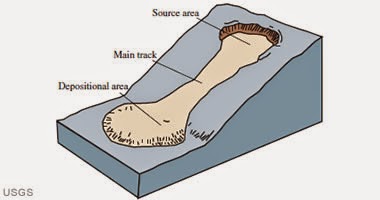 Earthflows are downslope, viscous flows of saturated, fine-grained materials, which move at any speed from slow to fast. Typically, they can move at speeds from 0.17 to 20 km/h (0.1 to 12.4 mph). Though these are a lot like mudflows, overall they are more slow moving and are covered with solid material carried along by flow from within. They are different from fluid flows because they are more rapid. Clay, fine sand and silt, and fine-grained, pyroclastic material are all susceptible to earthflows. The velocity of the earthflow is all dependent on how much water content is in the flow itself: if there is more water content in the flow, the higher the velocity will be.
Earthflows are downslope, viscous flows of saturated, fine-grained materials, which move at any speed from slow to fast. Typically, they can move at speeds from 0.17 to 20 km/h (0.1 to 12.4 mph). Though these are a lot like mudflows, overall they are more slow moving and are covered with solid material carried along by flow from within. They are different from fluid flows because they are more rapid. Clay, fine sand and silt, and fine-grained, pyroclastic material are all susceptible to earthflows. The velocity of the earthflow is all dependent on how much water content is in the flow itself: if there is more water content in the flow, the higher the velocity will be.
These flows usually begin when the pore pressures in a fine-grained mass increase until enough of the weight of the material is supported by pore water to significantly decrease the internal shearing strength of the material. This thereby creates a bulging lobe which advances with a slow, rolling motion. As these lobes spread out, drainage of the mass increases and the margins dry out, thereby lowering the overall velocity of the flow. This process causes the flow to thicken. The bulbous variety of earthflows are not that spectacular, but they are much more common than their rapid counterparts. They develop a sag at their heads and are usually derived from the slumping at the source.
Earthflows occur much more during periods of high precipitation, which saturates the ground and adds water to the slope content. Fissures develop during the movement of clay-like material which creates the intrusion of water into the earthflows. Water then increases the pore-water pressure and reduces the shearing strength of the material.
Debris landslide
A debris slide is a type of slide characterized by the chaotic movement of rocks soil and debris mixed with water or ice (or both). They are usually triggered by the saturation of thickly vegetated slopes which results in an incoherent mixture of broken timber, smaller vegetation and other debris. Debris avalanches differ from debris slides because their movement is much more rapid. This is usually a result of lower cohesion or higher water content and commonly steeper slopes.
Steep coastal cliffs can be caused by catastrophic debris avalanches. These have been common on the submerged flanks of ocean island volcanos such as the Hawaiian Islands and the Cape Verde Islands. Another slip of this type was Storegga landslide.
Movement: Debris slides generally start with big rocks that start at the top of the slide and begin to break apart as they slide towards the bottom. This is much slower than a debris avalanche. Debris avalanches are very fast and the entire mass seems to liquefy as it slides down the slope. This is caused by a combination of saturated material, and steep slopes. As the debris moves down the slope it generally follows stream channels leaving a v-shaped scar as it moves down the hill. This differs from the more U-shaped scar of a slump. Debris avalanches can also travel well past the foot of the slope due to their tremendous speed.
Sturzstrom
A sturzstrom is a rare, poorly understood type of landslide, typically with a long run-out. Often very large, these slides are unusually mobile, flowing very far over a low angle, flat, or even slightly uphill terrain.
Shallow landslide
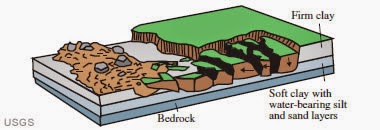
Landslide in which the sliding surface is located within the soil mantle or weathered bedrock (typically to a depth from few decimetres to some metres)is called a shallow landslide. They usually include debris slides, debris flow, and failures of road cut-slopes. Landslides occurring as single large blocks of rock moving slowly down slope are sometimes called block glides.
Shallow landslides can often happen in areas that have slopes with high permeable soils on top of low permeable bottom soils. The low permeable, bottom soils trap the water in the shallower, high permeable soils creating high water pressure in the top soils. As the top soils are filled with water and become heavy, slopes can become very unstable and slide over the low permeable bottom soils. Say there is a slope with silt and sand as its top soil and bedrock as its bottom soil. During an intense rainstorm, the bedrock will keep the rain trapped in the top soils of silt and sand. As the topsoil becomes saturated and heavy, it can start to slide over the bedrock and become a shallow landslide. R. H. Campbell did a study on shallow landslides on Santa Cruz Island California. He notes that if permeability decreases with depth, a perched water table may develop in soils at intense precipitation. When pore water pressures are sufficient to reduce effective normal stress to a critical level, failure occurs.
Deep-seated landslide
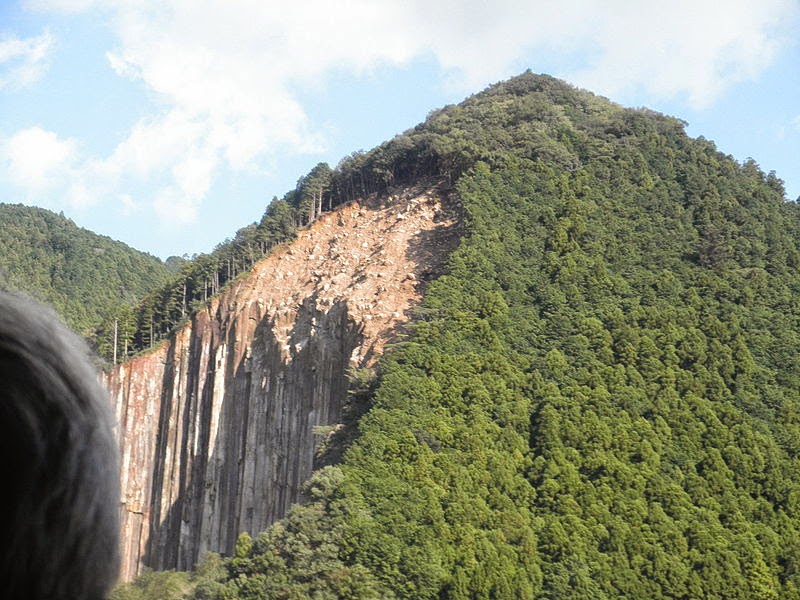
Landslides in which the sliding surface is mostly deeply located below the maximum rooting depth of trees (typically to depths greater than ten meters). Deep-seated landslides usually involve deep regolith, weathered rock, and/or bedrock and include large slope failure associated with translational, rotational, or complex movement. This type of landslides are potentially occur in an tectonic active region like Zagros Mountain in Iran. These typically move slowly, only several meters per year, but occasionally move faster. They tend to be larger than shallow landslides and form along a plane of weakness such as a fault or bedding plane. They can be visually identified by concave scarps at the top and steep areas at the toe.
Types and classification
In the following table shows a schematic landslide classification adopting the classification of Varnes 1978 and taking into account the modifications made by Cruden and Varnes, in 1996. Some integration has been made by using the definitions of Hutchinson (1988) and Hungr et al. 2001.
Factors Influencing Landslide Risk
Bluff Characteristics
Height: The height of a bluff can generally indicate landslide risk. While sediment strength depends on several factors, the thicker the sediment deposit, the more likely its weight will cause subsurface movement or slippage that leads to a landslide. The risk of a landslide increases when mud bluffs have a height of twenty feet or more. In general, the higher the exposed bluff face the greater the risk of a landslide.
Sediment type: Earth material that makes up a coastal bluff influences the risk of a landslide occurring. Clay and silt (muddy) sediment is the most unstable material that can make up a bluff. These fine-grained sediments are weak and prone to moving in the form of slow-motion creep, moderate-sized slumping, or large landslides. Sand and gravel deposits tend to be stronger and better drained than muddy sediment. Landslides can occur in coarse-grained bluffs although they are less frequent than muddy landslides along the Maine coast.
Slope: Coastal bluffs have a relatively steep ocean-facing slope. The angle of a bluff face varies due to factors such as the sediment type and rate of erosion at the base of the bluff. Slope is also affected by the history of slumps and landslides at the site. Some slopes are uniformly straight while others are terraced or uneven due to earth movements. In general, the steeper the slope, the easier it is for gravity to initiate a landslide.
Vegetation: Types, shapes, and distribution of vegetation above and on a bluff face can be used as an indication of site stability. In areas where the soil has shifted, either due to previous landslides or to gradual surface creep, many tree trunks can become tilted or twisted in the same direction. Curved tree trunks near the roots often indicate land movement down the face of a bluff. Large trees on the bluff face may be moved by wind and resulting root motion may loosen bluff sediment. Natural vegetation that consists only of small shrubs and trees may indicate recent bluff erosion or a landslide.
Bedrock: Crystalline rock or ledge is much more stable than any sediment bluff and not likely to erode or slide. The elevation of bedrock at the shore and inland beneath a bluff is important in determining landslide risk. Bedrock exposures along the shoreline may slow erosion and make sediment less susceptible to landsliding. Beneath a sediment bluff, bedrock may rise toward the surface and reduce the overall thickness of sediment and thus reduce the risk of deep-seated movement below the ground surface.
Natural Conditions
Waves, tides, and sea level: Several marine processes affect the risk of landslides along a coastal bluff. A gradual, but ongoing rise in sea level at a rate of about an inch per decade is causing chronic erosion along the base of many bluffs. As sea level rises, wave action and coastal flooding can reach higher and farther inland and scour more sediment from a bluff. Sea ice erodes tidal flats and the base of bluffs by abrasion and freezing sediment in ice blocks. Erosion can increase a bluff slope and make it more susceptible to landsliding. Tides are also important in washing away eroded bluff sediment which helps wave action move inland. Storms that create wind, waves, and flooding can cause more extreme erosion at the base of a bluff, increase the bluff slope, and make a landslide more likely.
Surface water: The amount, type, and location of surface water can influence bluff slope stability and may contribute to some landslides. Wetlands, ponds, and streams above the bluff can supply water to the bluff face and also to the ground water. The elevation or topography of the land surface determines which way surface water will flow. Water that runs over the face of a bluff can wash sediment to sea, increase the bluff face slope, and weaken the remaining sediment holding up the bluff. Removal of sediment from the bluff face can increase the risk of a landslide.
Ground water: Ground water inland of a bluff comes from surface sources, such as rain or a stream, uphill in the local watershed. Ground water tends to flow horizontally beneath the surface and may seep out the face of a bluff. Seeps and springs on the bluff face contribute to surface water flow and destabilize the bluff face. In addition, a high water table can saturate and weaken muddy sediment and make the ground more prone to slope failure.
Weathering: Weathering in clay and silt can change the strength of bluff sediment and stability of the bluff face. Drying of clay can increase resistance to sliding. The seasonal cycle of freezing and thawing of the bluff face can lead to slumping after a thaw.
Earthquakes: Landslides can be triggered by earthquakes. Ground vibration loosens sediment enough to reduce the strength of material supporting a bluff and a landslide results. Most landslides triggered by earthquakes in sediment like that found in Maine have been of Richter magnitude 5 or more. These are relatively rare events, but a few have occurred in historical time.
Human Activity
Land use: Human activity and land use may contribute to or reduce the risk of a landslide. Actions that increase surface water flow to a bluff face, watering lawns or grading slopes, add to natural processes destabilizing the bluff face. Surface water, collected by roofs, driveways, paths, and lawns flows toward and down the bluff face. Walkways down the face of a bluff can lead to greater erosion from foot traffic or the concentration of surface water flow. Both surface and ground water above a bluff can be supplied by pipes, culverts, surface drains, and septic systems. Increased water below ground can weaken a bluff and contribute to internal weakness that leads to a landslide. Greater seepage of water out of the bluff face can also increase the risk.
Clearing of vegetation from the bluff face can lead to greater bluff erosion and a steeper bluff that is more prone to landslide. Vegetation tends to remove ground water, strengthen soil with roots, and lessen the impact of heavy rain on the bluff face.
Adding weight to the top of a bluff can increase the risk of a landslide. Buildings, landscaping, or fill on the top of the bluff can increase the forces that result in a landslide. Saturating the ground with water that raises the water table also adds weight. Even ground vibration, such as well drilling or deep excavation, may locally increase the risk of a landslide.
Shoreline engineering in the form of seawalls, rip rap, or other solid structures is sometimes used to reduce wave erosion at the toe of a bluff. In some settings, engineering can increase the rate of beach or tidal flat erosion and lower the shore profile over time. This intertidal erosion can undermine engineering and result in less physical support of the base of the bluff by natural sediment. Where engineering ends along a shore, erosion can become worse on adjacent properties. Engineering alone cannot prevent some large landslides.
In general, human activities that increase the amount or rate of natural processes may, in various ways, contribute to landslide risk.
Video
Reference:
Wikipedia: Landslide
Wikipedia: Landslide classification
U.S. Geological Survey: Landslide Types and Processes
Wikipedia: Causes of landslides
Maine Department of Agriculture, Conservation and Forestry: Factors Influencing Landslide Risk
U.S. Geological Survey: Landslide in Washington State










